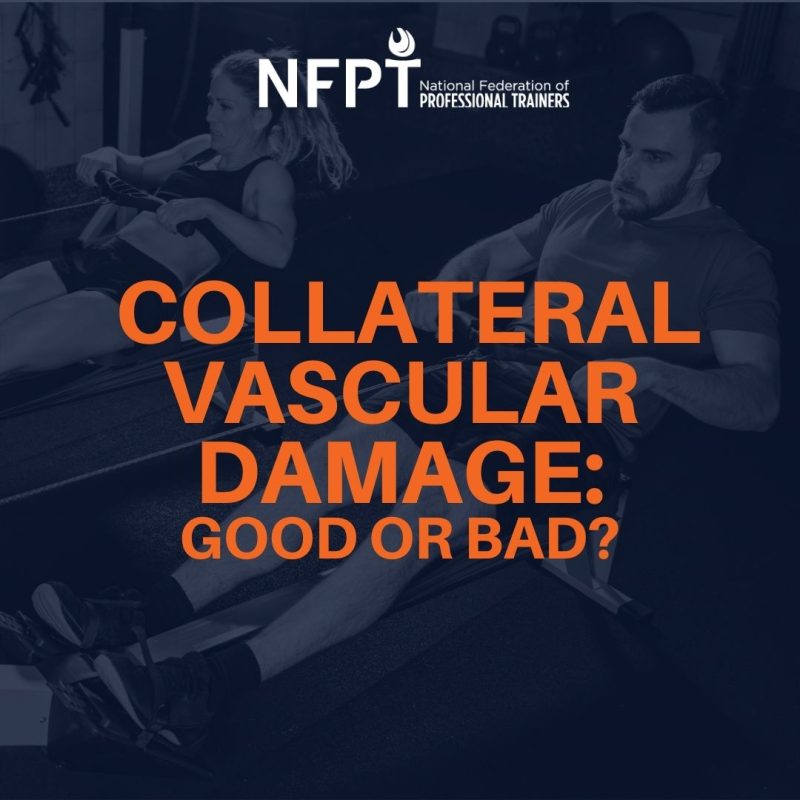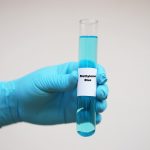
Collateral damage refers to any unintended side effects that may result from an initially positive endeavor. Bodybuilding and resistance training programs carry the potential for damage at the cellular and vascular levels. Here we explore the physiology of various aspects of weightlifting and how to capture the upside of collateral damage. The collateral vascular damage inflicted by weight training occurs regardless of one’s specific intentions and to varying degrees based on training intensity, duration, frequency, and volume. Fortunately, it is possible to optimize the benefits of this damage by knowing its specific causes and effects.
Muscle Tissue & Collateral Circulation
Let’s begin by discussing the anatomical location where this exercise-induced damage occurs. The collateral circulation perfuses the intramuscular areas in the form of microscopic capillaries and small veins. These small and fragile capillaries transport oxygen and nutrient-rich blood from the main arteries to the muscles, while the equally small and fragile venules work with the lymphatic system to carry expelled muscle tissue wastes and oxygen-deficient blood back to the main vascular tree. These small vessels facilitate the exchange of nutrients and oxygen on a cellular level.
This collateral vascular tissue is quite delicate and branches extensively throughout the muscular areas. There is no doubt that the greater the volume of these intramuscular vessels the greater the health of the surrounding lean tissue. In fact, any body tissue cell that is sufficiently supplied with nutrient-rich blood using collateral circulation has the benefit of the full benefit of the cardiorespiratory system, performing more optimally and living longer than those not readily perfused by collateral blood vessels.
Adipose Tissue
There is also, of course, collateral circulation in other body tissues such as adipose and organ tissue. It is thought by some researchers that the greater the volume of collateral blood provision to fatty tissue, the greater the conversion and storage of circulating calories (mostly over-abundant glucose, triglycerides, and fatty acids). This is undesirable when it comes to weight maintenance and general health.
Collateral Vascular Damage via Volume Training and Prolonged Contraction
Capillary damage occurs when resistance exercise calls on the target muscle to maintain a sustained contraction for prolonged periods. The longer the duration and the greater the intensity of the sustained contraction, the greater the capillary damage. The greater the volume of high-rep sets performed, the greater the damage, as well.
During prolonged contraction, the girth of the working tissue increases enough to ‘pinch’ or block the flow of blood to the working muscles much like the act of pinching a garden hose. With this ‘pinching’ comes a back-up of pressurized blood not able to enter the working intramuscular region. Upon relaxation, the blood quickly perfuses into the now relaxed musculature. This pressurized perfusion results in the bursting of already very fragile microscopic capillaries causing an ‘escape’ of blood in and around the working muscles. The extent of the damage will be based on the variables of duration, intensity, and most importantly, volume.
The repeated performance of high rep sets back to back (volume training) clearly amplifies the rock-hard pump that is the hallmark of volume/high rep training. This so-called ‘pump’ occurs due to the collateral veins’ and the lymphatic system’s inability to capture and then return this exercise-induced increase in escaped intramuscular fluid back to the main vascular tree.
Not only are wastes removed slower during a pump, but cellular nutrient and oxygen provision is adversely affected as well. In short, fluids remain in the intramuscular areas for longer periods when experiencing the pumped sensation.
Since nutrient provision and waste removal are both limited during this pump, it becomes directly prohibitive to size and strength training if performed exclusively. Many resistance trainees with scarce body fat covering a particular working muscle during high rep/volume training can see burst capillaries beneath the fascial layer appearing in the form of bruising.
One can consider the vessel damage to require a fairly long recovery period, about the same as that of muscle tissue. Not unlike muscle tissue damage sustained during training, protein is needed to repair these tiny vessels–which are themselves muscle tissue, as well.
Similar to muscle tissue growth during recovery, when these small vessels are repaired, they, in turn, form new branches. This is the cardiovascular tissue’s way of preparing itself for the next exercise session and it leads to a slight increase in muscle size. This usually is caused mainly by the temporary increase in fluid remaining in the musculature just trained.
The body’s muscular areas feature an extensive network of delicate vascular tissue. The greater the volume of these intramuscular blood vessels and capillaries, the greater the health of the surrounding lean tissue. Any tissue sufficiently supplied with nutrient- rich blood utilizing circulation can perform more optimally than those not readily perfused by blood vessels.
The Pump
The repeated performance of high-rep sets back-to-back amplifies the rock-hard visual, that highly desirable hallmark of volume training and visible impact of collateral vascular damage. This “pump” simply represents the inability of the veins and lymphatic system to capture and then return the increase in escaped intramuscular fluid. Waste removal slows during a pump, as do cellular nutrient and oxygen provision. As such, this situation prohibits positive size/strength development if performed exclusively.
As trainers, we teach clients that the collateral damage of microtears in muscle tissue, which develops from overload training, facilitates size and strength progress. In a sense, the “pump” directly negates this ability; swelled muscles subside post-workout. That coveted appearance, then, is merely temporary and not a sign of real growth.
Not only are wastes removed more slowly during a pump, but cellular nutrient and oxygen provisions also suffer. In short, fluids remain in the intramuscular areas for longer periods when experiencing the pumped sensation. Athletes with scarce body fat can see burst capillaries beneath the fascia (appearing in the form of bruising) when working muscles at high repetitions/volume training.
While the above would give one reason to think the ‘pump’ is something best avoided, it is important to realize that these vessels will recover fully. What’s more, the newly formed branches act to improve and make more efficient the movement of blood in the intramuscular regions. This increased proficiency will also facilitate greater muscle growth in the long run as well. The affected muscle tissue becomes more efficient, which is the groundwork for defining better health for all exercise participants young and old, male or female, regardless of individual goals.
The burning sensation associated with the ‘pump’ is unmistakable and is the universal indicator of capillary extension. The above information can be thought of as an argument in favor of phase training, holistic training, periodization, etc. All people who use resistance training benefit most from a regular dose of high-rep training to enhance the exchange of nutrients and wastes on a cellular level.
For weight training enthusiasts looking for size and strength increase, consider employing some high-rep training occasionally to optimize energy provision and improve cellular performance.
The Truth Behind Lactic Acid
Lactic acid, often labeled the collateral damage “scapegoat” for post-exercise muscle soreness, actually clears simultaneously with its production, continuing for several minutes following intense exercise. At some point, however, lactate accumulation interferes with the very muscle function for which it was previously providing energy, resulting in muscle fatigue. Once muscle failure occurs, the amount of rest time required before resuming equally intense effort depends on one’s type of rest period observed: active or inactive.
DOMS, or “delayed onset muscular soreness”, likely results from musculotendinous micro-injury, not lactic acid accumulation.
As for the burning sensation and side pains that had heretofore been ascribed to a build-up of lactic acid, scientists now believe it follows from anaerobic ATP production and the hydrolysis of that ATP, resulting in increased proton release in the form of hydrogen ions. An accumulation of hydrogen ions lowers the body’s pH; such acidosis in turn prevents oxygen from binding to hemoglobin in red blood cells. When the body faces reduced oxygen transport to skeletal muscle, ATP (energy) production suffers.
Calcium and Muscle Failure
Calcium contributes to muscle contraction by binding to a protein that signals contraction within the sarcomere; as this occurs, the entirety of the muscle shortens. Both hydrogen ions and excess inorganic phosphate (accumulated from the breakdown of ATP) directly affect calcium release; impaired release will diminish the contraction, resulting in true muscular fatigue.
Time-Under-Tension
Conventional wisdom holds that while growing lean muscle tissue, one must concurrently get stronger. This resonates until we also consider the one major drawback to low-rep training: muscle-fiber stimulation, and thus growth, correlates directly to the amount of time a muscle remains under tension. Short but intense sets lasting 15 seconds or less will develop strength, but prove ineffective at encouraging muscle growth. Hypertrophy results from performing sets that last 30 seconds to a minute in duration.
Mechanical tension refers to heavy lifting, generating the largest muscle force possible through a full range of motion. However, we must point out the fallacy in the notion that the heavier one lifts, the more mechanical tension produced. A 2013 study by Pinto, et al. found that muscle activation in an isometric bench press peaked at 90% of maximal voluntary contraction.
This suggests that most lifters have a “sweet spot” below the one-rep max for which mechanical effort functions at its highest. Adding weight past this point fails to increase mechanical tension, and may even shift it away from the desired muscles and onto more passive structures. Based on this knowledge, clients would benefit more by working at 90% of their 1 REP max. More reps can be successfully achieved, thereby ensuring all-important time-under-tension.
An upper-body workout aimed at maximizing strength can directly impact a subsequent identical upper-body workout. If a client engages solely in upper-body hypertrophy workouts, training frequency becomes limited by fatigue specificity. However, by understanding the advantages of alternating upper-body strength and hypertrophy sessions, we can help clients train more frequently and still see progress.
Overtraining
When factoring in sources of collateral damage related to serious weightlifting, we cannot ignore the multitude of pitfalls associated with overtraining. In many serious athletes, overtraining can result in the body overproducing both cortisol and DHEA.
These substances, the body’s long-acting “stress hormones”, actually counteract each other. DHEA facilitates anabolic development, while cortisol plays a more catabolic role. The delicate balance typically found between these two gets thrown off-kilter during periods of overtraining. If allowed to continue, elevated levels of cortisol (coupled with decreased amounts of DHEA) can have far-reaching negative effects:
- Increase in cholesterol and triglyceride production
- Depletion of the B vitamins, calcium and magnesium
- Reduction of protein synthesis/increased catabolism
- Reduction of circulating levels of growth hormone, leading to a weakened immune system
- Elevated blood sugar levels due to insulin function impairment
- Sleep disruption
- Decreased metabolism/increased fat storage
Take-Home Message
The collateral damage inflicted by weight training occurs regardless of one’s goals, and to varying degrees based on training intensity, duration, frequency, and volume. Personal trainers and athletes can learn more about this damage by knowing its specific causes and effects. We can help our clients discern the truth behind the physiological changes, thwart the negative side effects, and achieve their goals in the gym.
References
www.bodybuilding.com/content/rest-and-overtraining-what-does-this-mean-to-bodybuilders.html






